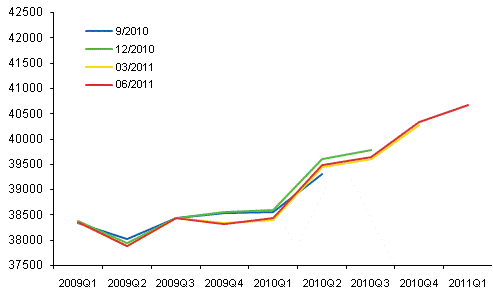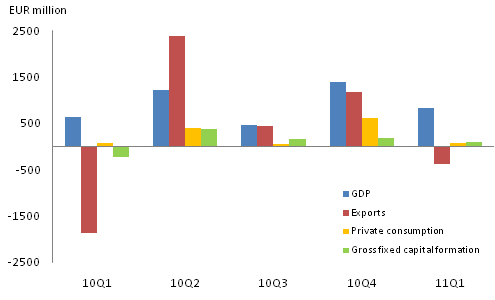1. Investments increased the economy in the first quarter, a good amount of taxes on products accumulated
In the first quarter of 2010, the volume of Finland’s gross domestic product increased by 0.8 per cent from the previous quarter. Adjusted for working days, gross domestic product was 5.5 per cent up on the fourth quarter of 2010. Calculated at current prices, GDP adjusted for working days grew by 9.7 per cent year-on-year.
The tariff increases of taxes on products are visible in the tax revenue of the first quarter, which was 20 per cent larger than one year previously.
The bottom of the strong economic downturn in 2008 and 2009 seems to have been reached in the second quarter of 2009. Since then, GDP has been growing slowly again and has now more or less attained the same level as in 2007.
Figure 1. Revisions - seasonally adjusted volume of GDP by release

Other European economies are also gradually recovering from the downturn. According to preliminary data compiled by Eurostat, in the first quarter of 2011 GDP in the EU-27 area went up by 0.8 per cent from the previous quarter.
1.1. Output
In primary production, that is, agriculture, forestry and fishing, the volume of value added was in the first quarter 3.8 per cent smaller than in the previous quarter and 1.6 per cent lower than one year previously.
Output in manufacturing fell slightly in the first quarter. Its value added was 0.3 per cent down on the previous quarter but 8.7 per cent up on the respective quarter twelve months back. In the wood and paper industry value added diminished by two per cent from the previous quarter but increased by 9.4 per cent year-on-year. In the metal industry (incl. electrical and electronics industry) value added decreased by 1.5 per cent from the previous quarter but increased by 13.5 per cent from one year back. In other manufacturing value added grew by 0.8 per cent from the quarter before and by 5.5 per cent year-on-year.
The volume of value added in construction grew in every quarter of last year and the growth continued in the first quarter of the current year as well. In the January to March period, output increased by 0.6 per cent from the previous quarter and by 6.6 per cent from one year back.
Value added in services went up by one per cent from the previous quarter and by 4.1 per cent year-on-year. In trade value added was 0.2 per cent up on the previous quarter and 6.6 per cent up year-on-year. Transport, storage and communications grew by 0.6 per cent from the previous quarter and by 7.6 per cent from one year back. In real estate and business activities value added increased by one per cent from the previous quarter and by 4.7 per cent from one year back.
The volume of total value added generated by all industries grew by 0.4 per cent from the previous quarter and by five per cent from twelve months back.
1.2. Imports, exports, consumption and investments
In the first quarter, total demand grew by 1.9 per cent from the previous quarter and by 8.2 per cent year-on-year. In particular, investments increased demand. The development of exports was, in turn, weak.
Figure 2. GDP and expenditure components, change from previous quarter (seasonally adjusted, at current prices)

In the first quarter, the volume of exports decreased by 4.8 per cent from the previous quarter but was 15.9 per cent up year-on-year. Exports of goods diminished by 2.6 per cent and those of services by nine per cent from the previous quarter. The volume of imports grew by 2.2 per cent from the previous quarter and was 11.9 per cent up year-on-year. Imports of goods increased by 0.2 per cent and imports of services by 10.1 per cent from the previous quarter.
The volume of private consumption remained on level with the previous quarter but grew by 2.3 per cent year-on-year. The volume of public consumption expenditure went up by 0.7 per cent from the previous quarter and by 1.2 per cent year-on-year.
In the first quarter, the volume of investments increased by 2.6 per cent from the quarter before and by 9.8 per cent year-on-year. Construction investments went up by 2.2 per cent from the previous quarter and by 10.7 per cent from one year back. The volume of investments in machinery, equipment and transport equipment increased by 3.6 per cent from the previous quarter and by 7.6 per cent year-on-year. Private investments increased by 2.4 per cent and public investments by 8.8 per cent from the quarter before.
1.3. Employment, wages and salaries and national income
In the first quarter, the number of employed persons went up by 0.3 per cent from the previous quarter and was 0.8 per cent higher than one year previously. The number of hours worked in the national economy similarly increased by 0.3 per cent from the previous quarter and by 0.9 per cent from one year back.
According to Statistics Finland’s Labour Force Survey, the rate of unemployment in the January to March period was 8.6 per cent. In the corresponding period of 2009, it stood at 9.3 per cent.
In the January to March period, the nominal wages and salaries bill of the national economy grew by 1.7 per cent from the previous quarter and by 5.5 per cent year-on-year. The operating surplus (net), which in business bookkeeping corresponds roughly with business profit, grew by 22 per cent at current prices from twelve months back. Gross national income calculated at current prices was 9.7 per cent higher one year previously.
1.4. The available data
These preliminary data on the first quarter of 2011 are based on the source information on economic development that had become available by 25 May 2011.
The annual level data for 1990 to 2009 correspond with the National Accounts data released on 28 January 2011 with the exception of transactions with the rest of the world (exports, imports, primary income from the rest of the world), which may deviate from annual accounts data when revised. The data for 2010 have become revised with respect to nearly all economic transactions and thus deviate from the data released on 1 March 2011. National Accounts data concerning the second quarter of 2011 will be released on 5 September 2011, when the data for previous quarters will also be revised.
Due to the benchmarking and seasonal adjustment methods, quarterly data may be slightly revised as regards the whole time series in connection with each release. Major revisions take place, however, during the next two to three years following the release on the quarter, because final annual accounts data are published at a lag of around two years from the end of the statistical reference year. Seasonally adjusted and trend time series always become revised against new observations irrespective of whether the original time series becomes revised or not.
Methodological description of Quarterly National Accounts : http://tilastokeskus.fi/til/ntp/men_en.htmll
Source: National Accounts 2011, 1st quarter. Statistics Finland
Inquiries: Pasi Koikkalainen (09) 1734 3332, Samu Hakala (09) 1734 3756, kansantalous.suhdanteet@stat.fi
Director in charge: Ari Tyrkkö
Updated 3.6.2011
Official Statistics of Finland (OSF):
Quarterly national accounts [e-publication].
ISSN=1797-9765. 1st quarter 2011,
1. Investments increased the economy in the first quarter, a good amount of taxes on products accumulated
. Helsinki: Statistics Finland [referred: 31.12.2025].
Access method: http://stat.fi/til/ntp/2011/01/ntp_2011_01_2011-06-03_kat_001_en.html

